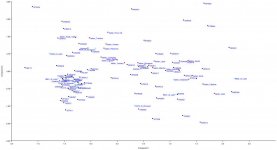@Archetype0ne,
Pax preceded me and has already answered on several points adding a new PCA.
There is no doubt that Tarquinia/TAQ is a fundamental Etruscan centre. But if you notice, most of the samples from Tarquinia/TAQ are in the "northern" cluster (so quite close to the current Iberians and Italian Lombards), apart from a minority of individuals that are either of "mixed"/foreign origin (outliers?) and/or could be dated to a later phase, when Tarquinia becomes Roman (it was so since the beginning of the III century BC), with probable deduction/immigration of external people.
After all, the Etruscan population was spread over a large area of the Peninsula, which - sooner or later - put them in contact with other peoples, diversifying them. A similar hypothesis could be advanced on POP001 (from Populonia? which by the way - as a mining and metallurgical centre - I expect attracted various immigrants).
However, these are just conjectures, just to entertain the wait for the publication of precise data: in addition to solving the riddle of the initials of the locations (although it seems to me that on the identification TAQ = Tarquinia we are all quite ready to bet), it would be really useful to know the dating of the samples, which also cover periods after the flourishing of the Etruscans. Otherwise we risk a bit of what happened with the Moots/Antonio paper 2 years ago, where all the inhabitants of Rome in the imperial age are made to pass as paradigmatic of the entire Italic population, without regard to the actual historical phases and the many locations other than Rome.
Pax will be able to be more precise than me here: Latins and Etruscans seem to be rather similar or related from a genetic point of view in their early phases, but I think more that a certain closeness of the Etruscans to the Central-Eastern European world is due to that steppe component present in the Etruscans incubated in some Bronze Age phase of the Danubian-Balkan area (the major suspects should be the cultures of Mokrin and Maros), some fringes of which will move a little further West, giving rise to the proto-Italic populations and/or overlapping with the Anarian substratum (Neolithic + WHG) from which the Etruscans will emerge, while those remaining in situ will proceed with the Indo-Europeanisation of the Balkans.
I see I have rather similar results to yours, comparing them with these samples, I'm not surprised, the reasons may be more than one and we may never get to the bottom of it. I stick to the following 3, which are not mutually exclusive:
1) equal shares of ancestral components between central-northern Italians and preslavic Balkan populations, which almost automatically overlaps us in the oracles
2) precisely that probable common steppe background mentioned above, from which both the Indo-European Balkans and the Proto-Italic ones proceeded
3) more recent migrations, also of Roman and medieval/Byzantine age, along the Adriatic Sea

| Distance to: | Dodecadk12bStuvanè |
|---|
| 4.12127407 | ETR007 |
| 5.96436920 | TAQ009 |
| 6.18798836 | POP001 |
| 6.31981012 | TAQ011 |
| 6.68472139 | TAQ022 |
| 7.80932776 | TAQ020 |
| 8.33039615 | ETR003 |
| 9.15716659 | ETR010 |
| 10.23210145 | CSN009 |
| 10.26249970 | VEN017 |
| 10.50968601 | VEN001 |
| 10.54409788 | VET001 |
| 10.71946361 | CSN005 |
| 10.81554437 | TAQ003 |
| 11.19209096 | MAS001 |
| 11.35817327 | ETR013 |
| 11.38123016 | VEN008 |
| 11.93949748 | ETR006 |
| 12.07552069 | TAQ006 |
| 12.56003583 | VEN006 |
| 12.81852566 | VOL001 |
| 12.93006961 | VEN013 |
| 13.61044819 | VEN016 |
| 13.78004717 | CSN008 |
| 13.92520736 | VEN015 |
| Distance to: | Dodecad_Glob_13Stuvanè |
|---|
| 3.50182809 | ETR007 |
| 6.47319087 | TAQ011 |
| 7.28703643 | MAS001 |
| 7.68488126 | TAQ009 |
| 7.78856213 | TAQ022 |
| 8.38830734 | VEN010 |
| 8.41722638 | POP001 |
| 8.55021637 | VEN009 |
| 9.11615050 | ETR003 |
| 9.54094335 | VEN008 |
| 9.94562718 | ETR010 |
| 10.04199681 | VET001 |
| 10.51667723 | VEN018 |
| 10.61888883 | CSN005 |
| 10.63110060 | ETR006 |
| 10.66085831 | ETR013 |
| 11.68427148 | CSN009 |
| 11.74483716 | VEN001 |
| 11.87424945 | TAQ003 |
| 11.94143626 | CSN013 |
| 11.99305632 | CSN006 |
| 12.04318064 | TAQ006 |
| 12.27419651 | VOL001 |
| 12.35918687 | TAQ015 |
| 12.66158758 | TAQ016 |








